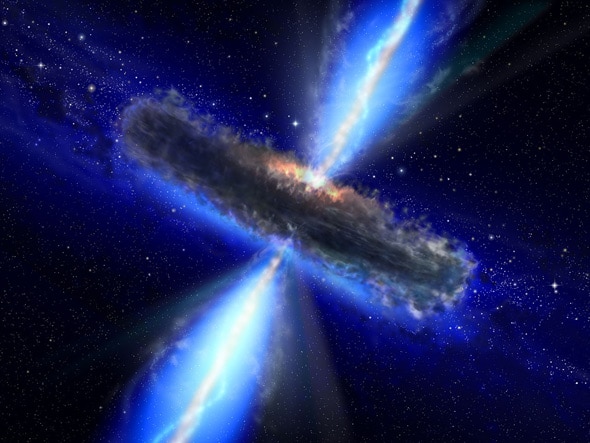Create a free profile to get unlimited access to exclusive videos, sweepstakes, and more!
Astronomers Take the Measure of a Monster Black Hole

Seventy million light-years from Earth lies the somewhat odd galaxy NGC 1332. It falls somewhere in between the two main galaxy types of elliptical and spiral; it’s disk shaped but lacks obvious spiral arms and is quite elongated.
Like all big galaxies, though, it has a black hole in its very center. And not just any black hole, but a supermassive black hole. Current astronomical thinking is that these monsters form at the same time as the galaxy, and affect each other’s growth. Gas pours down to the center from the growing galaxy, feeding the black hole, and the black hole also emits a ferocious wind that can curtail the birth of stars in the galaxy.
When we look at a galaxy now, billions of years later, we see correlations between the mass of the black hole and the behavior of the galaxy. Because of that, knowing the mass of the black hole is important in understanding how galaxies are born, age, and evolve.
But how do you measure the mass of a black hole?
Isaac Newton helps us here. Objects near the black hole orbit it, and the speed at which they move (together with their distance from it) reveals the strength of the gravity of the black hole. That in turn—as Newton pointed out 400 years ago—depends on the mass doing the pulling.
It’s not that simple, of course! But it can be done, and has been done. A camera I worked on for Hubble, called STIS, was designed in part to be able to make these kinds of measurements.
For NGC 1332, various methods have been used, including measuring the velocities of stars near the center of the galaxy (and therefore close to the black hole) and looking at hot gas surrounding the galaxy. These methods have some issues, though, and can have large uncertainties.
A new telescope has come online recently, though, and has something to say about the matter. ALMA, the Atacama Large Millimeter/submillimeter Array, is a collection of large and very sensitive telescopes that detect light well outside the energy our eyes can see—between infrared and radio waves. Very cold gas and dust emit light in this range, and that’s where ALMA comes into the game.
Many black holes have huge, swirling disks of dust around them. These can be several hundred light years across, the whole thing moving around the supermassive black hole at high speed. Even though they’re big, from 70 million light-years away they look small and hard to see. ALMA, though, has terrific vision, able to resolve the disk down to just a dozen or so light-years from the central black hole.
That’s important. More than about 75 light-years out from the black hole, the gravity of the stars in the central region of the galaxy start to dominate; an estimated 10 billion stars exist within the central 750 light-years. So the closer you are to the black hole, the less an effect the stars have over the hole.
Measuring the disk rotation speed depends on measuring the Doppler effect: The part of the disk rotating around the black hole and heading toward us gets its light blueshifted (the wavelength gets compressed) while the side heading away from us is redshifted (the wavelengths get longer). ALMA can measure these shifts all along the disk, thereby measuring its velocity at different distances from the black hole.
By carefully modeling the gravitational effects of stars and the black hole and applying them to their observations, astronomers using ALMA have determined that the black hole has a mass of—I hope you’re sitting down—660 million times the mass of the Sun.
That’s a lot of hole.
As supermassive black holes go, that’s pretty supermassive-y. Quite a few have been found that are even bigger, but 660 million solar masses is pretty big. The Milky Way’s central black hole has a mass of only (!) about 4 million times the mass of the Sun, for comparison. So the one in NGC 1332 is a lot heftier than ours.
The good news is that this mass jibes with what’s been found for that galaxy using the other, independent methods. That gives us confidence the answer is correct. And the uncertainty in the ALMA measurements is pretty good, only about ±10 percent, better than most other measurements.
And it means we have yet another tool in our kit to measure the masses of these monsters. To put this in context, the ALMA observations aren’t a groundbreaking discovery, but they’re something just as important: a new way to probe distant cosmic objects. ALMA can perform similar observations on other galaxies, building up a census of black hole masses, which can be combined with all our other knowledge to help us better understand the lives of galaxies.
Galaxies are in many ways the building blocks of the Universe, and we happen to live in one, so I’m all for understanding them better. Everything we learn in this way is a piece of the puzzle and adds to the picture we build of the Universe.
I’m all for that, too.














